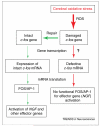Ischemic injury and faulty gene transcripts in the brain
- PMID: 11576672
- PMCID: PMC2726704
- DOI: 10.1016/s0166-2236(00)01918-4
Ischemic injury and faulty gene transcripts in the brain
Abstract
The brain has the highest metabolic rate of all organs and depends predominantly on oxidative metabolism as a source of energy. Oxidative metabolism generates reactive oxygen species, which can damage all cellular components, including protein, lipids and nucleic acids. The processes of DNA repair normally remove spontaneous gene damage with few errors. However, cerebral ischemia followed by reperfusion leads to elevated oxidative stress and damage to genes in brain tissue despite a functional mechanism of DNA repair. These critical events occur at the same time as the expression of immediate early genes, the products of which trans-activate late effector genes that are important for sustaining neuronal viability. These findings open the possibility of applying genetic tools to identify molecular mechanisms of gene repair and to derive new therapies for stroke and brain injury.
Figures




References
-
- Englander EW, et al. Hypoxia-induced mitochondrial and nuclear DNA damage in the rat brain. J. Neurosci. Res. 1999;58:262–269. - PubMed
-
- Chen D, et al. Detection of DNA base-excision repair activity for oxidative lesions in adult rat brain mitochondria. J. Neurosci. Res. 2000;61:225–236. - PubMed
-
- Solenske NJ, et al. Differential hydrylation of salicylate in core and penumbra regions during focal reversible cerebral ischemia. Stroke. 1997;28:2545–2551. - PubMed
-
- Cherian L, et al. Nitric oxide concentrations in the brain after controlled cortical impact injury in rats. J. Neurophysiol. 2000;83:2171–2178. - PubMed
-
- Kumura E, et al. Generation of nitric oxide and superoxide during reperfusion after focal cerebral ischemia in rats. Am. J. Physiol. 1996;270:C748–C752. - PubMed
Publication types
MeSH terms
Grants and funding
LinkOut - more resources
Full Text Sources
Other Literature Sources

